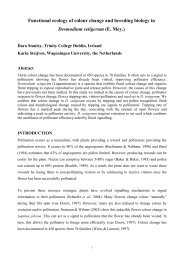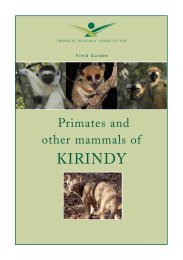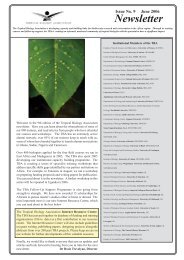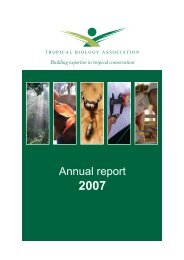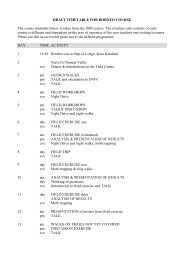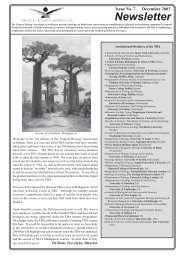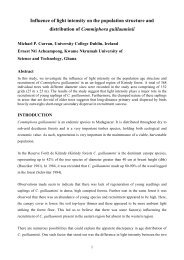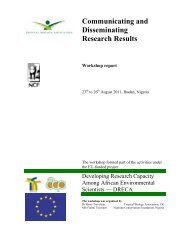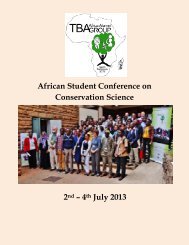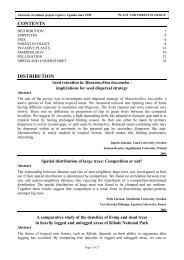Download TAAG Book of Abstracts - Tropical Biology Association
Download TAAG Book of Abstracts - Tropical Biology Association
Download TAAG Book of Abstracts - Tropical Biology Association
Create successful ePaper yourself
Turn your PDF publications into a flip-book with our unique Google optimized e-Paper software.
Beehive and honey losses caused by bush burning to<br />
beekeepers in Adjumani District, Uganda<br />
Moses Chemurot 1 , Patrice Kasangaki 2 , Ojja Francis 3 ,<br />
Eric Sande 1 and Gilbert Isabirye-Basuta 1<br />
1 Makerere University, P.O. Box 7062, Kampala, Uganda.<br />
2 National Livestock Resources Research Institute, P.O.<br />
Box, 96 Tororo.<br />
3 Adjumani District Local Government, P.O. Box, 2<br />
Adjumani.<br />
Corresponding author email:<br />
moseschemurot@gmail.com<br />
Abstract<br />
This paper examines annual beehive and honey losses<br />
due to bush burning among beekeepers in Adjumani<br />
District, northern Uganda. It seeks to quantify numbers<br />
<strong>of</strong> beehives and quantify honey losses together with<br />
economic losses accruing annually to beekeepers from<br />
the rampant bush burning so that government agencies<br />
can counter any breakdown in livelihood strategies and<br />
improve the quality <strong>of</strong> life <strong>of</strong> the beekeepers. We<br />
interviewed beekeepers on the number <strong>of</strong> hives lost to<br />
bushfires and estimates <strong>of</strong> honey lost to bush burning.<br />
The capacities <strong>of</strong> honey measuring containers used by<br />
beekeepers were estimated and always referred to for<br />
conversion. This information was later compared with<br />
field observations to get a better assessment <strong>of</strong> the<br />
losses. The results indicate that 29.6% <strong>of</strong> the<br />
beekeepers reported loss <strong>of</strong> beehives and honey to bush<br />
burning. On average a beekeeper lost 3 beehives. A<br />
total <strong>of</strong> 387 beehives were lost by 152 farmers sampled.<br />
The total projection <strong>of</strong> the number <strong>of</strong> beehives and<br />
honey lost in the district in the dry season <strong>of</strong> 2010/2011<br />
were 1067 and 10,456.6kg respectively. This quantity <strong>of</strong><br />
honey could have fetched approximately 41,826,400<br />
Uganda Shillings ($16,730.6) when sold locally in<br />
Adjumani. Therefore bush burning is a big threat to<br />
livelihood strategies in Adjumani and if controlled, there<br />
is great potential for increased honey production,<br />
household incomes and increased local revenue.<br />
Environmental degradation caused by vegetation<br />
burning and free range <strong>of</strong> livestock in search for pasture<br />
was clearly evident. We recommend quick interventions<br />
such as implementation <strong>of</strong> the district environment<br />
ordinance and other environmental laws.<br />
Increasing Nutritional value <strong>of</strong> the Oyster mushroom<br />
by incorporating Gliricidia sepium in the growing<br />
substrate<br />
John Richard<br />
Tanzania Forestry Research Institute P.O. Box<br />
1854Morogoro, Tanzania<br />
Email for correspondence: jorijomb@yahoo.com<br />
Abstract<br />
Mushroom cultivation has recently gained attention <strong>of</strong><br />
both small and large investors as it requires little space,<br />
less water utilization and is one <strong>of</strong> the important foods<br />
to people living with HIV AIDS. For communities living<br />
adjacent to forest reserves, mushroom cultivation has<br />
successfully been used as an alternative source <strong>of</strong><br />
income thus reduces pressure to the forest. However,<br />
there is an increasing concern on the nutritional value as<br />
contents in the mushroom primarily depend on the<br />
substrate on which they grow. The study was therefore<br />
carried out to determine the amount <strong>of</strong> protein, and<br />
minerals in mushrooms following amendment <strong>of</strong> rice<br />
straw with Gliricidia sepium foliage. Mushrooms were<br />
cultivated in polythene bugs, whereby six treatments<br />
i.e. different ratios <strong>of</strong> Gliricidia foliage to rice straw (0%,<br />
5%. 10%, 15% 20% and 25%) were applied in the<br />
growing substrate. Protein and minerals from the<br />
harvested mushrooms were analyzed in the laboratory<br />
to determine the content <strong>of</strong> crude protein and minerals<br />
(i.e. Manganese, Copper, Potassium, Calcium,<br />
Magnesium and Zinc). There was an increase <strong>of</strong> 40%<br />
protein in the substrate (rice straw) amended with 10%<br />
Gliricidia foliage. Further increase <strong>of</strong> Gliricidia foliage in<br />
the growing substrate not only reduced the amount <strong>of</strong><br />
protein but also inhibited the uptake <strong>of</strong> minerals such as<br />
Potassium, Magnesium, Zinc and Manganese. The<br />
increase in protein is significant and it shows that<br />
Gliricidia highly improves nutritional value <strong>of</strong> the<br />
mushroom.<br />
Keywords: Oyster mushroom, Gliricidia, nutritional,<br />
protein, substrate<br />
Keywords: Beekeeping, apiary, fire, economics, loss<br />
<strong>TAAG</strong> First African Student’s Conference, Nairobi. 2-4 July, 2013 55




